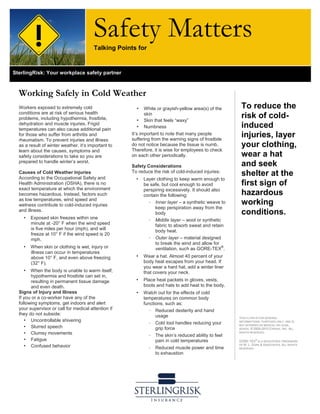Working Safely in Cold Weather
- 1. Working Safely in Cold Weather Workers exposed to extremely cold conditions are at risk of serious health problems, including hypothermia, frostbite, dehydration and muscle injuries. Frigid temperatures can also cause additional pain for those who suffer from arthritis and rheumatism. To prevent injuries and illness as a result of winter weather, itŌĆÖs important to learn about the causes, symptoms and safety considerations to take so you are prepared to handle winterŌĆÖs worst. Causes of Cold Weather Injuries According to the Occupational Safety and Health Administration (OSHA), there is no exact temperature at which the environment becomes hazardous. Instead, factors such as low temperatures, wind speed and wetness contribute to cold-induced injuries and illness. ŌĆó Exposed skin freezes within one minute at -20┬░ F when the wind speed is five miles per hour (mph), and will freeze at 10┬░ F if the wind speed is 20 mph. ŌĆó When skin or clothing is wet, injury or illness can occur in temperatures above 10┬░ F, and even above freezing (32┬░ F). ŌĆó When the body is unable to warm itself, hypothermia and frostbite can set in, resulting in permanent tissue damage and even death. Signs of Injury and Illness If you or a co-worker have any of the following symptoms, get indoors and alert your supervisor or call for medical attention if they do not subside: ŌĆó Uncontrollable shivering ŌĆó Slurred speech ŌĆó Clumsy movements ŌĆó Fatigue ŌĆó Confused behavior ŌĆó White or grayish-yellow area(s) of the skin ŌĆó Skin that feels ŌĆ£waxyŌĆØ ŌĆó Numbness ItŌĆÖs important to note that many people suffering from the warning signs of frostbite do not notice because the tissue is numb. Therefore, it is wise for employees to check on each other periodically. Safety Considerations To reduce the risk of cold-induced injuries: ŌĆó Layer clothing to keep warm enough to be safe, but cool enough to avoid perspiring excessively. It should also contain the following: - Inner layer ŌĆō a synthetic weave to keep perspiration away from the body - Middle layer ŌĆō wool or synthetic fabric to absorb sweat and retain body heat. - Outer layer ŌĆō material designed to break the wind and allow for ventilation, such as GORE-TEX ┬« . ŌĆó Wear a hat. Almost 40 percent of your body heat escapes from your head. If you wear a hard hat, add a winter liner that covers your neck. ŌĆó Place heat packets in gloves, vests, boots and hats to add heat to the body. ŌĆó Watch out for the effects of cold temperatures on common body functions, such as: - Reduced dexterity and hand usage - Cold tool handles reducing your grip force - The skinŌĆÖs reduced ability to feel pain in cold temperatures - Reduced muscle power and time to exhaustion To reduce the risk of cold- induced injuries, layer your clothing, wear a hat and seek shelter at the first sign of hazardous working conditions. SterlingRisk: Your workplace safety partner Safety MattersTalking Points for THIS FLYER IS FOR GENERAL INFORMATIONAL PURPOSES ONLY, AND IS NOT INTENDED AS MEDICAL OR LEGAL ADVICE. ┬® 2009-2010 ZYWAVE, INC. ALL RIGHTS RESERVED. GORE-TEX ┬« IS A REGISTERED TRADEMARK OF W. L. GORE & ASSOCIATES. ALL RIGHTS RESERVED.
